Kia Ora!
New Zealand 2023
Aoteareo
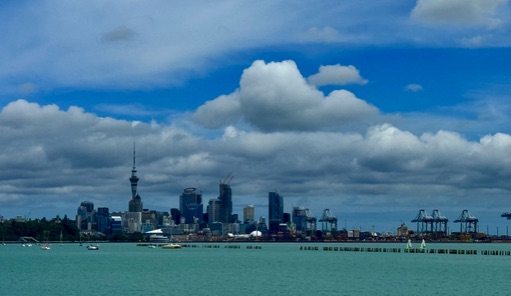

You might recall that Rick came down with COVID the NIGHT BEFORE we were flying to Italy to join six of our friends for a 3-week escapade across central Italy. Obviously, we didn't make it. New Zealand was our make up trip; because of short notice, no travel-friends could join us, so we went by ourselves with the same tour company, Overseas Adventure Travel. We WERE concerned about going with 14 "strangers," but our tour guide (stranger #15), Kristin, did an excellent job in bringing us all together - and we all became quick friends.
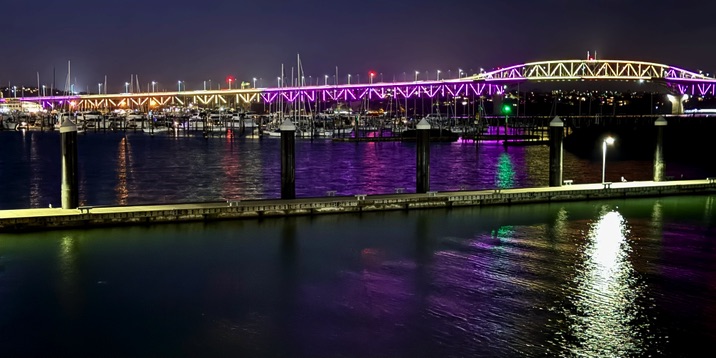
We arrived three days before the start of our tour, which gave us six days in the gorgeous port city of Auckland. As much as the Sky Tower became a guiding post for the city, our one effort to go up was thwarted by a private party (hey, we've never been up the Seattle Space Needle either!). The Aquarium, marine museum, inner harbor, art and cultural museums, The All Blacks Experience (rugby!), a ferry across the harbor to the quaint (and expensive!) town of Devonport; lots to do.
haere ra!
(good bye!)
Our first group outing was a half-day visit to a Maori community, complete with a thorough history of the struggles of the Maori people (did you know that thanks to a judicial decison, Harvard University now owns a huge swath of formerly Maori-owned timber land?); don't get me started on the country's questionable forestry practices (which mirror many US practices, so they're not alone).
A 45-minute ferry to Waiheke Island (note similarity between Maori & Hawaiian place names) for wine and olive oil tasting. OAT provided us with a great local bus/tour guide (a US ex-pat); it's remote (ferry ride to Auckland for most medical services); but its beauty is undeniable.
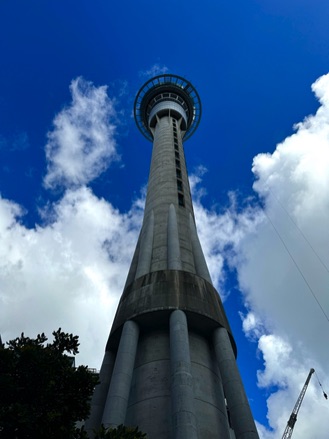
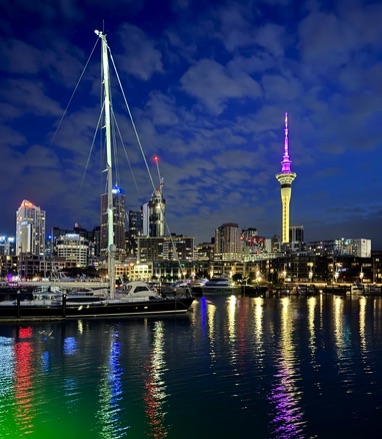
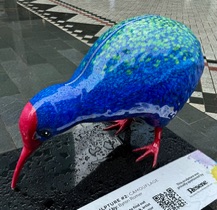
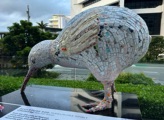
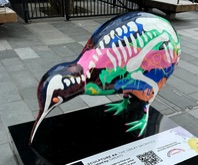
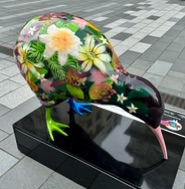
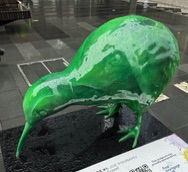
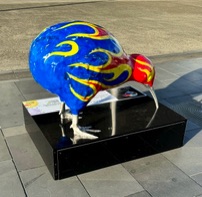
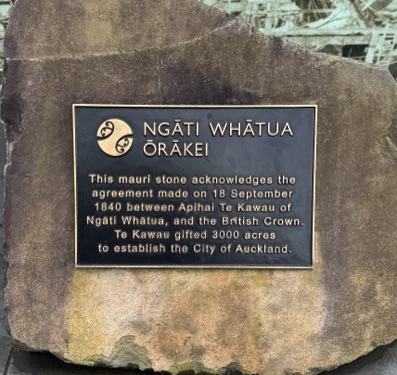
A condensed history of New Zealand: Polynesians landed in NZ circa 1280-1350, the last habitable land in the World, and developed a distinctive Maori culture (it's debatable if settlers originated from islands north of NZ or, possibly, from as far east as Peru; there clearly are Peruvian and Hawaiian and Asian influences).
The first European in NZ was a Dutch explorer in 1642, Abel Tasman (Rick's grandmother was an Abel, so he bears some responsibility) - thus the Tasman Sea west of NZ. The ubiquitous Capt. James Cook (of Hawai'i fame and ultimate death) accurately mapped the islands in 1769, the first European to visit the islands since Tasman 127 years previously. Of course, Christian missionaries later appeared, "converting" most of the Maori to Christianity.
As in the United States, clashes between European settlers (mostly from the UK) and native Maori marked the next half century before a treaty between the British and Maori was signed in 1840. Intepretations of the treaty are still argued in NZ courtrooms today.
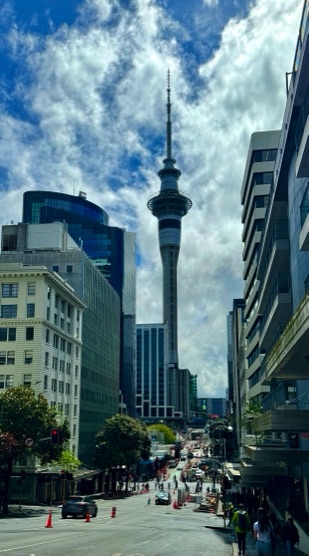
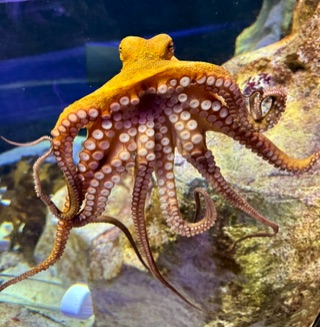
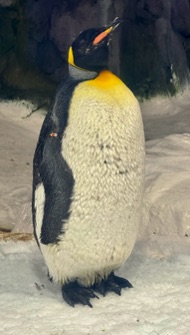

The painted kiwis were scattered about the harbour district; the octupus & live penguin in the aquarium; the totem warriors in the cultural museum; the tree canopy in the park by the art centre.
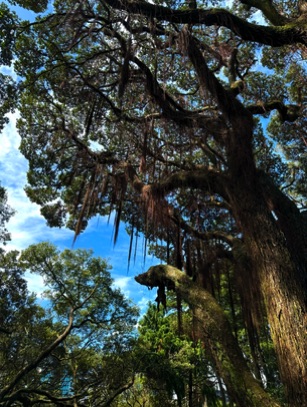

A funny, yet touching, sign at an Auckland bank; we could use dementia-friendly banking in the US; a friend- lobbyist tells me there is resistance from banks and credit unions; I'm sure if laws ever mandate it, they'll be the first to take full credit for it.
We finally met the full contingent of fellow travelers at a Saturday (11/4) meeting: 12 females of the 16; one couple cruised in from Vancouver; four females came as a pod; three groups of two came as traveling companions; two came as singles. We originated from Oregon, Idaho, Montana, Colorado, Virginia, Maine and several areas of California. Our experienced and personable tour guide, Kristin (below), hailed from the South Island, just north of Christchurch. It was tough to herd 16 for two weeks, but she pulled it off with humor, a quick smile, a gleam in her eyes and plenty of patience. She spoke perfect English, of course, but I found myself wanting at times for closed captioning because of her self-acknowledged thick Kiwi accent.
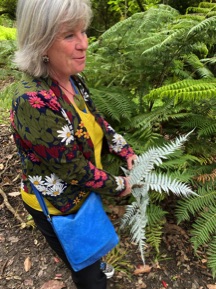
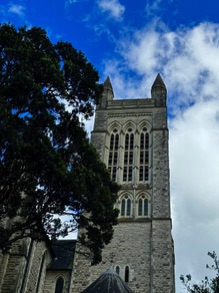


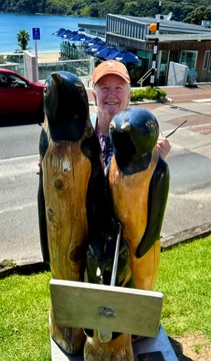
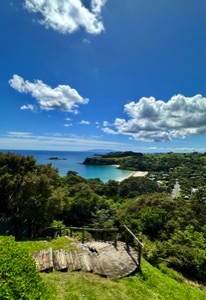
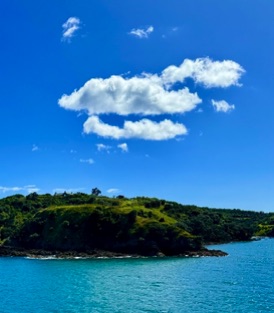
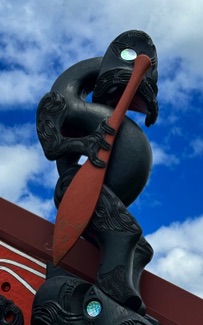
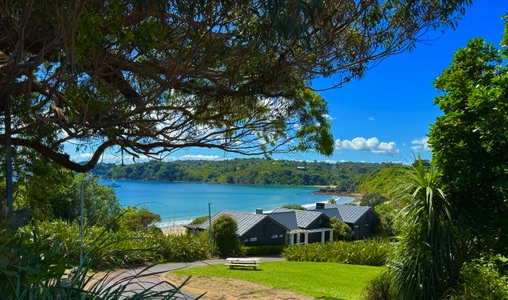
If visiting on your own, take a ferry out to Waiheke; rent bikes and tour the island. You might have to plan in advance for wine tasting, but olive oil tasting was open for drop ins.
We left Auckland and motor- coached SE toward Rotorua. Along the way we made two worthy stops: Hamilton Gardens (there are gardens everywhere, of course, and all very different) and a Kiwi rescue area.
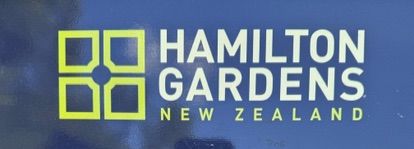
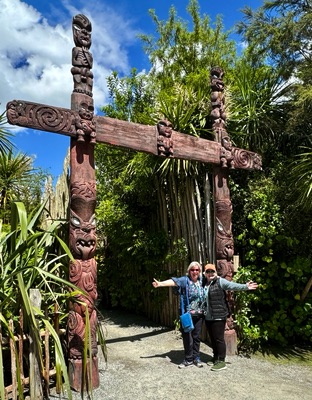
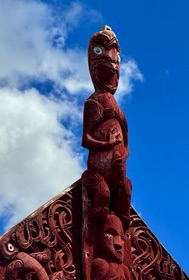
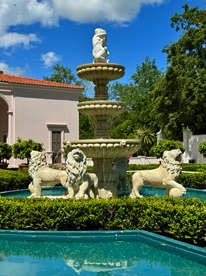
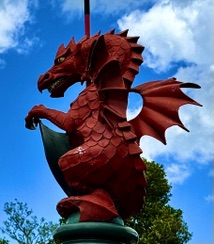

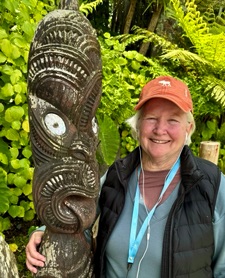

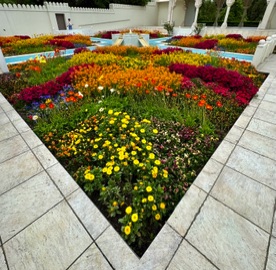
Tracy & Kristin (upper right) greet the group as we enter one of garden areas; there was even an Alice in Wonderland garden with oversized everything.
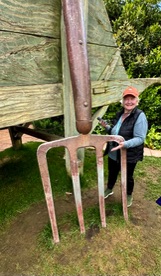
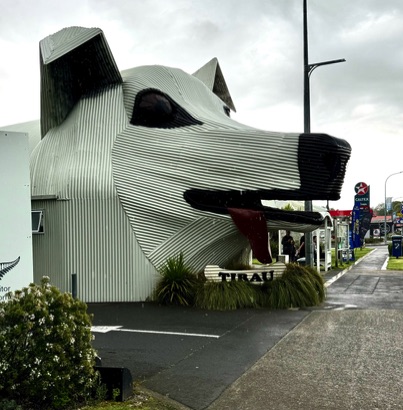
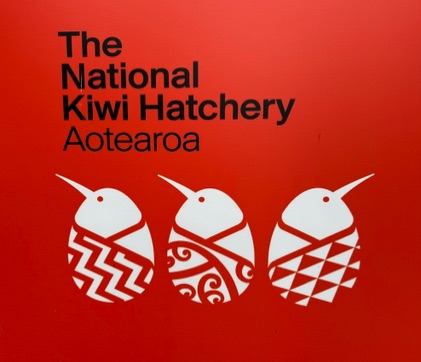
Whimsical potty stop (left). outside of Rotorua.
Then we made a stop at a kiwi hatchery, which appeared to be open for tour groups only. No photos were allowed inside, but we did get to see the incubation process and feeding of baby kiwis. Where once there were as many as 12 million kiwis in the wild, there are now fewer than 70,000.
Research teams collect eggs in the wild because of predation from invasive species (stoats, possums, pigs, cats) and loss of forest habitat. Females lay two eggs, a week or so apart, and the male sits on the eggs.
Releasing chicks back into the wild is far more successful than letting nature take its course; neither the male nor female look after the chicks after they hatch anyway. The males are radio-tagged so the researchers know exactly WHEN the male leaves the nest, leaving eggs for collection. It's an impressive operation.
This little guy is stuffed!
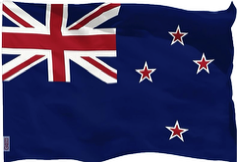
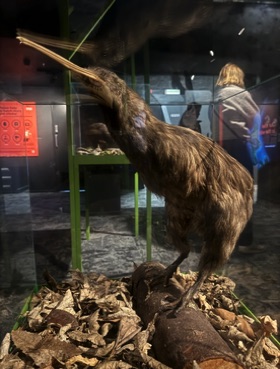

Waimangu Volcanic Valley: We had a wonderful tour guide direct us through this steamy valley of hot vernal pools and fresh water streams. It's a must if you're on the south side of the North Island. Unfortunately, our trip was suppose to culminate in a placid boat ride around Lake Rotomahana, but a mechanical failure kept us on the dock; its cancelation did not affect our overall enjoyment of the day.

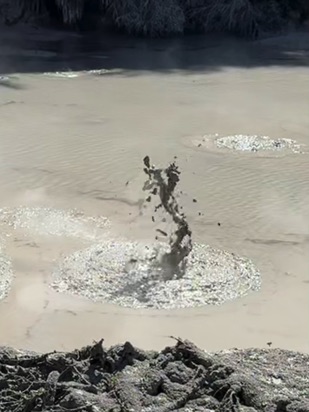
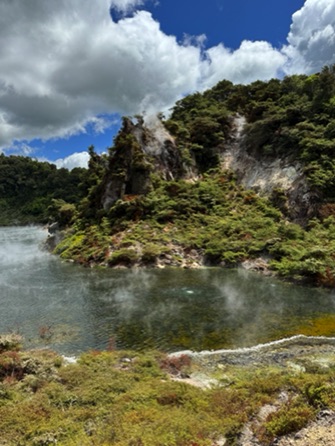

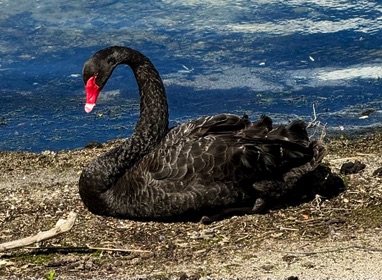
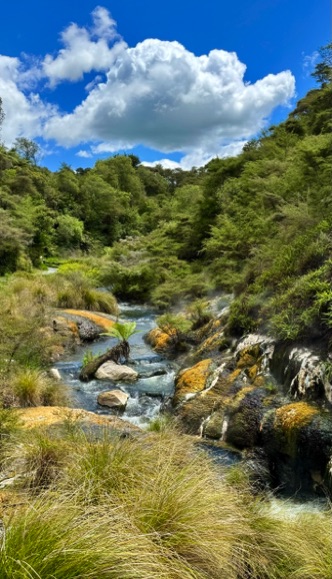

Black swans proliferate on the lake and in the Rotorua area.
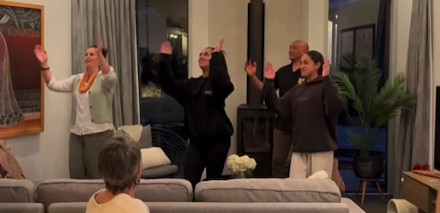
In the evening we participated in an iconic O.A.T. tradition: a home dinner with a local family. We were lucky to enjoy a stimulating evening with an upper-middle class Maori family (with two of their daughters home) who made excellent dinner companions. Randall is an accomplished artist and art teacher; Tina is a Dept. of Education mucky-muck. Before we departed they entertained us with a traditional Maori chant and dance; we reciprocated with a version of Woody Guthrie's This Land Is Your Land that we hope did the song justice.
The next day was another classic O.A.T. tradition: A Day in the Life. We visited a local Maori marae (in Murupara), where we learned about Maori religious traditions and customs (unfortunately. in my opinion, it was marred by a heavy dose of modern-day evangelicalism - why is it that traditional religions lose out to the conquerors?).
Our local guide (a wonderful, young Maori woman, Marianna) then led us to a traditional lunch feast! That was followed by an informative talk about Maori customs. (Note: NZ has three official languages: English, Maori and sign language).
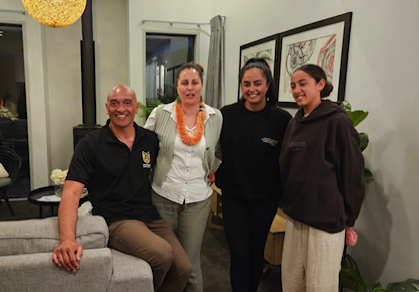
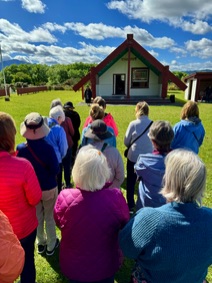
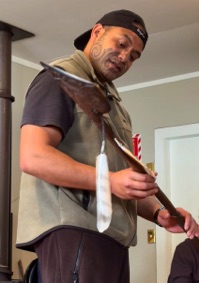
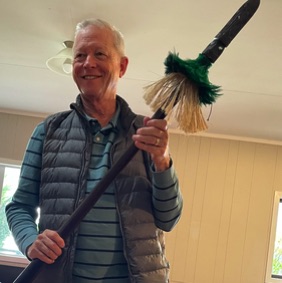
On to adventures on the South Island: Christchurch, Dunedin, Milford Sound & Queenstown!
You might recall the deadly 7.1 magnitude earthquake that hit Christchurch in February 2011; 185 people died, and there was widespread damage. The city is still recovering. Kristin lives north of Christchurch (the largest South Island city), and she recalls in detsil how it affected them and their lives since.
Historical notes: In 1893, New Zealand became the first nation to grant women the right to vote; in 1894, Kiwis were guaranteed the first ever minimum wage. Its independence was slow in coming, however: In 1907, the nation became a Dominion within the British Empire; it wasn't until 1947 that New Zealand divored itself from the British Parliament; today, it's much like Canada - the British sovereign is its monarchy, but England does not have any real influence in the country.
Of all of the war memorials in New Zealand, most are commemorative of World War I, which was a coming-of-age war for New Zealand. Almost 10% of the nation's population served overseas during the war; 17,000 Kiwis died and another 41,000 injured (the country's population at the time was one million).
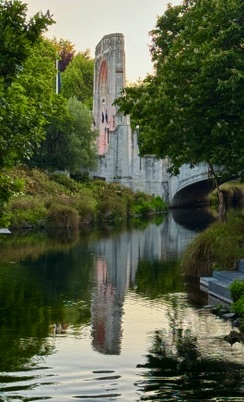
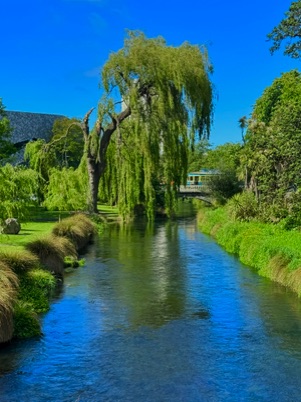
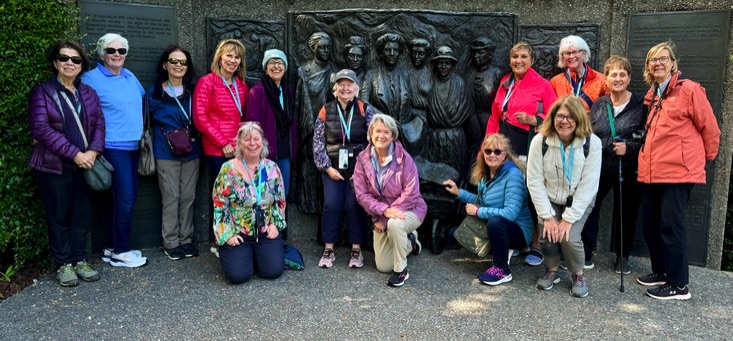
Christchurch has a vibrant downtown; the Avon River runs through its centre. On the left is the main war memorial (The Bridge of Remembrance); a tram system moves you around the downtown core; you can never go wrong taking a stroll through the town's botanical gardens. A local "kids park" had giant slides, zip lines - and plenty of adult participants. Below, all of our female travelers pose in front of a memorial to denote the 100th anniversary of the women's sufferage movement.
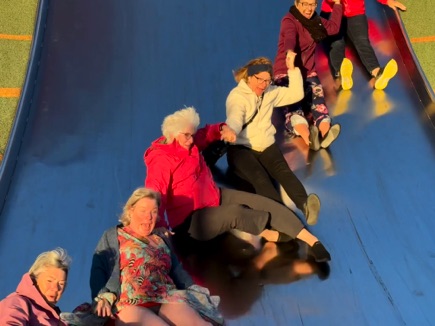
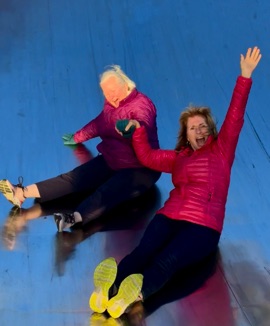
And yet another O.A.T. side-trip was a visit to a local working farm in the Rubicon Valley in the picturesque Southern Alps. (It's said there are about five sheep for every Kiwi resident; by the time we finished our trip through the South Island, we'd swear it was closer to 10 or 15.)
Here we got to see border collie (mixes) at work, alpacas and sheep shearing. We learned that wool from non-merino sheep wasn't worth the (monetary) effort; however, the sheep need to be sheared once or twice a year to protect their bodies from lice and other pests.
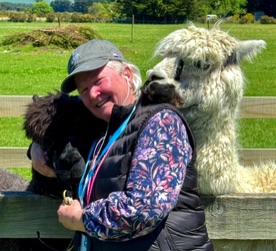
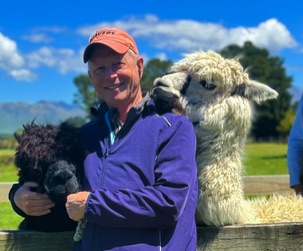
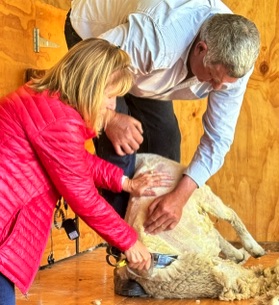
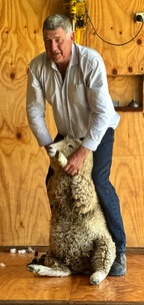
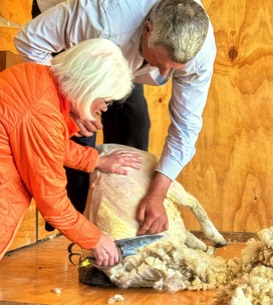
Leslie (l) & Paula (r) try their hands at sheep shearing the old fashioned way (by scissors shears rather than than mechanical shears). Not easy!
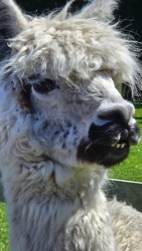
Kristin had an inside on a local private garden (Broadfield Garden) near Christchurch, and a bunch of us figured, 'Why not?' Glad we did! (It's for sale if anyone is interested.) Amazing how peaceful a place can be - and make you feel.
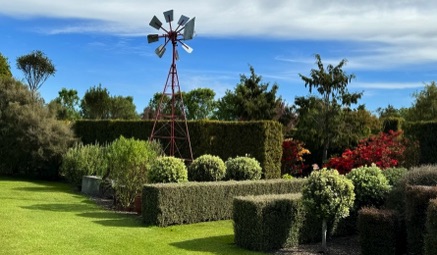
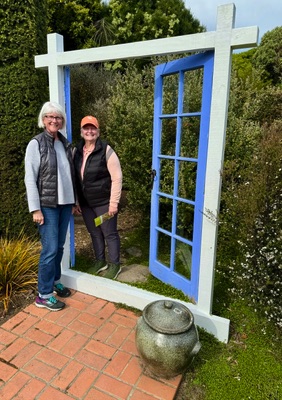
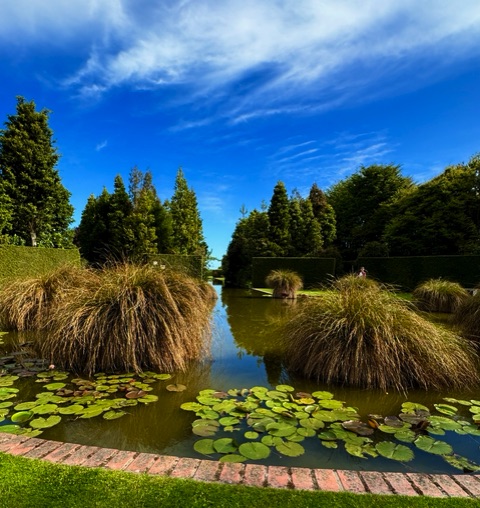
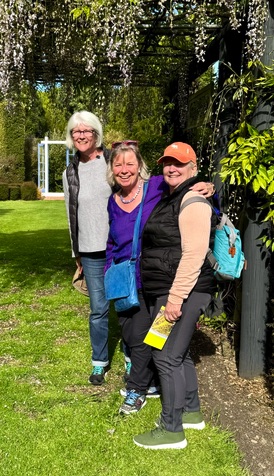
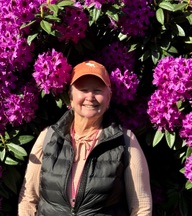
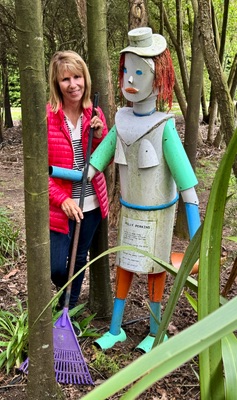
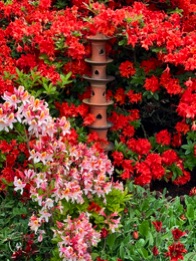
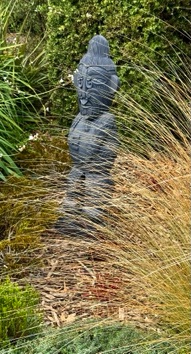
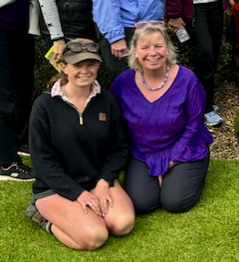
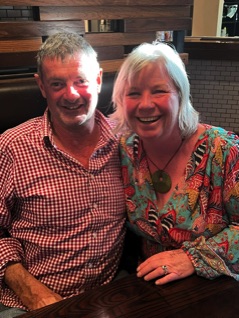
Above, Paula posing with her doppelganger (nah!); Leslie & Tracy in the doorway; Leslie, Kristin & Tracy.
Kristin was lucky (as were we) to be joined by her daughter, Briar, at the Garden - and later with husband/dad John at dinner. A special day for all.
Below, the group in the Garden - and Tracy about to enjoy a local dessert in Christchurch with her new friend.

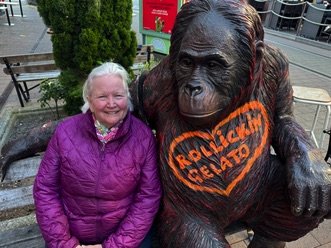
On the road south along the coast to Dunedin, Kristin had a few more treats in mind for us. First, a lunch stop at the picturesque coastal town of Oamaru, then a short beach hike to unique rock formations.
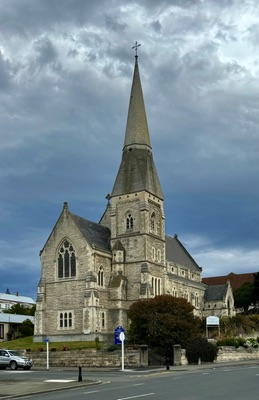
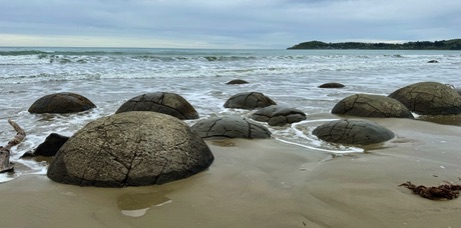
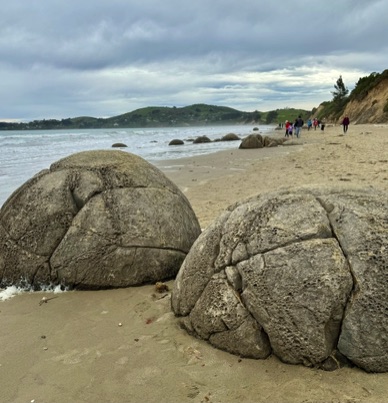
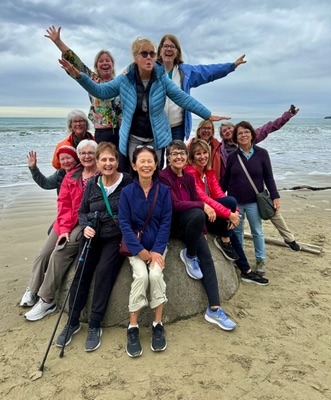
The Moeraki Boulders on the Koekohe Beach (there's that Hawaiian similarity again) are a scattered cluster of spherical rocks that appear almost toirtoise shell-like from a distance. There are plenty of Maori legends about their origins (e.g., eel baskets washed ashore from an overturned canoe); there are similar rock formations elesewhere in New Zealand, but this stretch of beach makes for a fun tourist stop!
You can see from the photo (left below) that this group of travelers is not having any fun at all; or maybe it's just happiness from getting to stretch their legs?
As we head into the southeast port town of Dunedin, Kristin has one more quirky side trip for us: The Steepest Street in the World. What?? Those of us with San Francisco thoughts were skeptical - until we made the hike up Baldwin Street!
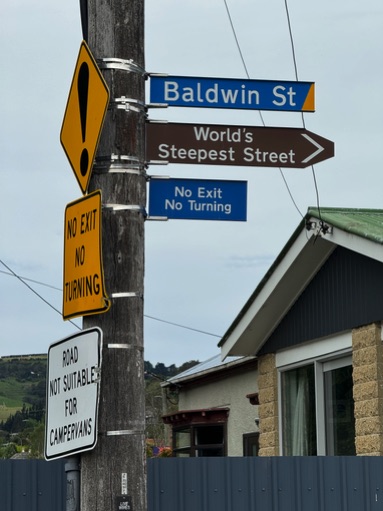
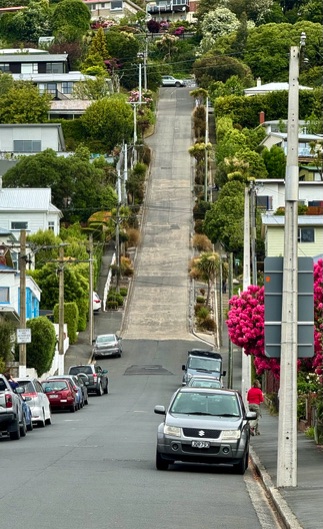
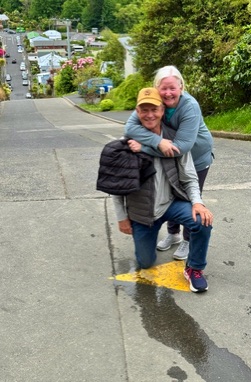
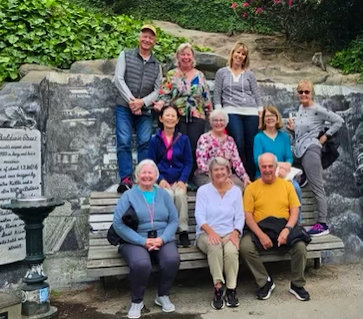
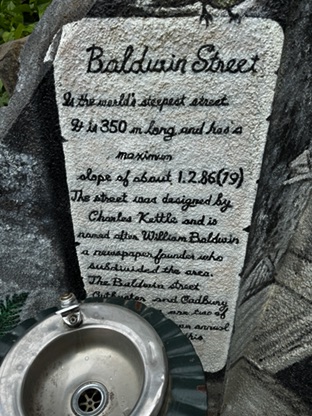
Baldwin Street in Dunedin: No, we didn't pogo stick up the hill; nor did we rollerblade it; we let others do that. But 10 us conquered the steepest street in the world - a 38 degree angle - and were happy we did.
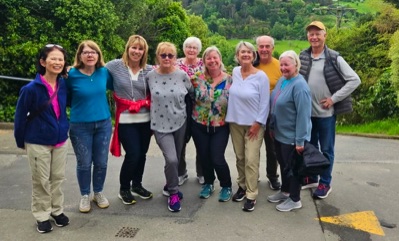
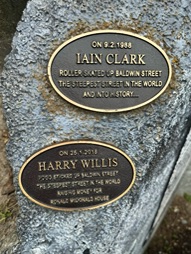
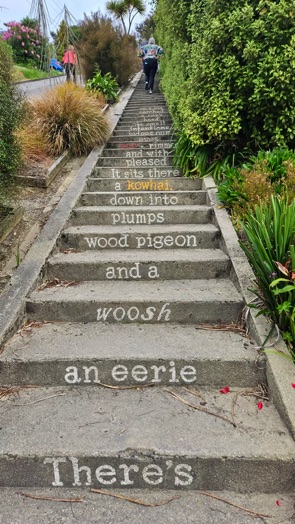
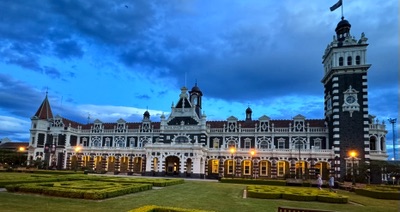
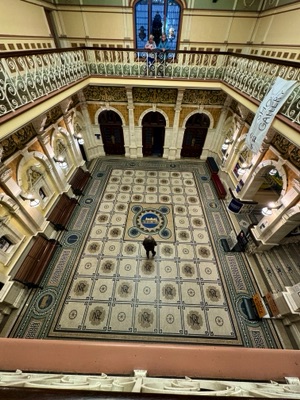
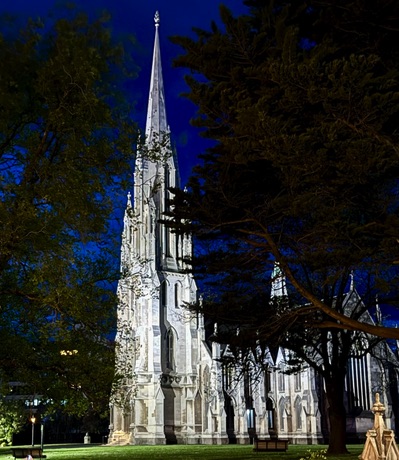
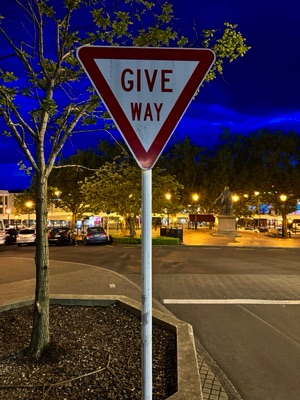
Dunedin is a charming port city (second largest on the South Island); we weren't there long, but we seemed to get plenty done. Besides Baldwin Street, we toured the Railway Station in the evening (below and right), and downtown after sunset. All "yield" signs in NZ display a different bent on the iconic triangled traffic sign.
The next day, we all went out to the far eastern part of the Otago peninsula to visit a gothic mansion - Larnach Castle - which had fallen into disrepair before being rescued by subsequent owners. It now stands as a landmark with gorgeous views of Otago Harbour, part of a long inlet from the sea to downtown Dunedin.
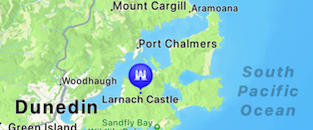
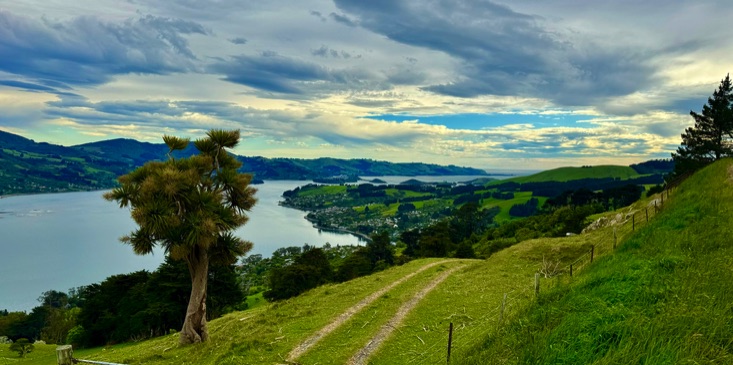
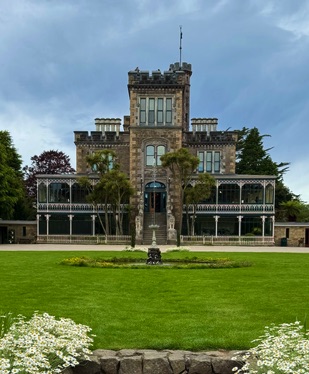
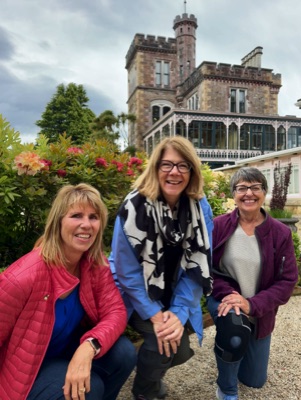
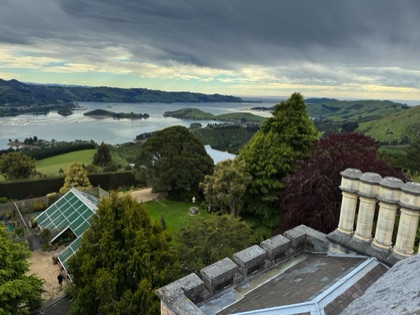
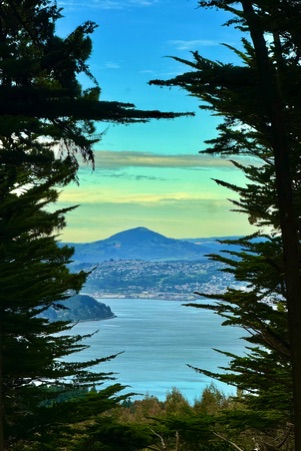
Above, on the road from Dunedin out to the castle on the hill.
Right, the Three Amigos from Escondido, Paula, Jackie & Judi.
Below left, the view from the turret looking northeast.
Below right, the view from the castle grounds looking back toward Dunedin in the distance.
In the afternoon, we split up. Several went to the Royal Albatross Centre, where they got great views of albatross soaring on the strong winds and good views of a penguin colony. Three of us took a bus trip out to the far end of the inlet, where we boarded a small boat (25 of us?) and cruised out to see albatross; we did get brief glimpses of dolphins and penguins in the water, but not as good as the Centre visitors got.
However, Tracy, Janet & I did have a most unique experience: We had a quality conversation with a young Israeli girl who was on our bus and boat with her younger sister and their mom. Remember, this is just five weeks after the October 7 Hamas attack on Israel. Their mother wanted them somewhere they could be safe - they were in NZ on a 3-month tourist visa - though the older one acknowledged that she had to return next September to begin her 2-year stint in the Israeli military (men serve 3-year terms). While we had great conversations with plenty of Kiwis, this encounter shook us a bit knowing what they and their fellow countrymen were experiencing. We left them with an invitation to visit us in Washington.
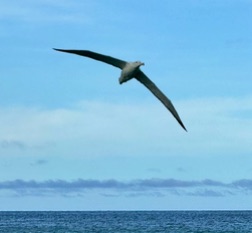
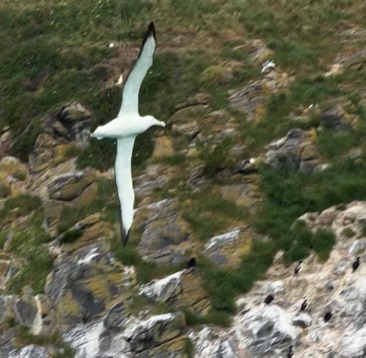
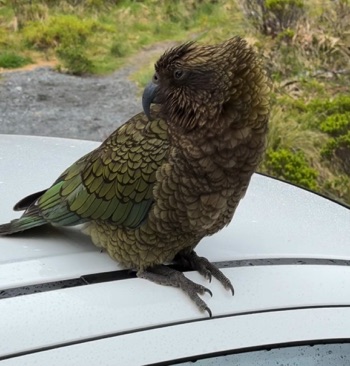
We left Dunedin the next morning. knowing that our ultimate adventure - Milford Sound - awaited us.
No sooner had Kristin told us to be on the look out for kea birds, there one was. Signs all over "Do Not Feed the Kea," there's been an on-going conservation effort (state-protected since 1986) to help this large (19") indigenous parrot.
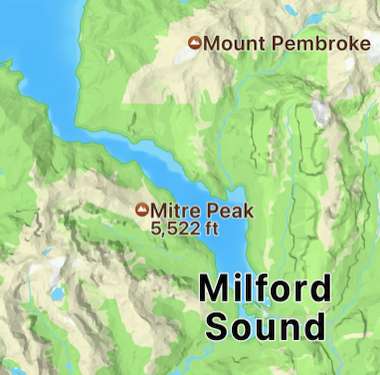
It's an impressive drive toward Milford Sound, with surrounding mountains reaching heights of more than 9,000 feet; the highest peak in the Southern Alps (on the west coast of the South Island) is Aoraki/Mount Cook, towering 12,218 feet above sea level.
(Captain Cook should get some recognition here because his 1770 expedition is credited with the first comprehensive (and mostly accurate) rendering of the entire island nation. The mountain received his name 80 years later and, because of cloud cover, it is believed that Cook never actually saw the mountain. The Maori, of course, had known of its existence for more than 400 years. Another irony is that Cook cruised past Milford Sound twice, yet never entered the secluded, 10-mile inlet)
It's clear that Milford Sound (Piopiotahi), the Eighth Wonder of the World (or so said Rudyard Kipling), is not a sound but a fiord (local spelling), and a damn impressive one at that. (Note: It's named after Milford Haven, a long, narrow inlet on the Welsh coast.)
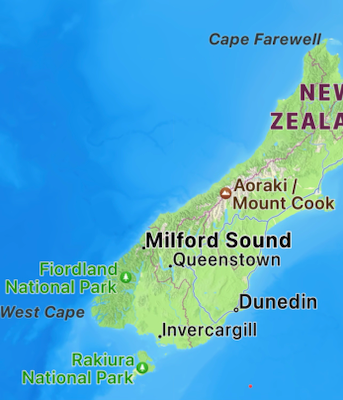
We were lucky that it was raining when we boarded our bost - it hailed on us a few hours later - because that allowed us to view the Sound in all of its waterfalled glory! Hundreds of various-sized falls cascaded down the sheer slopes, enough to form a layer of fresh water above the sea, as much as three feet deep. Glaciered peaks rose as high as 6,000 feet above us and plunged deep into the fiord.
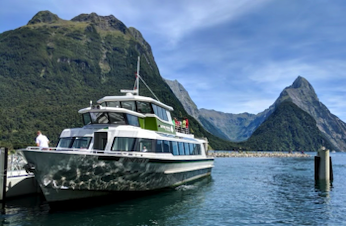
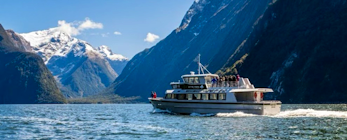
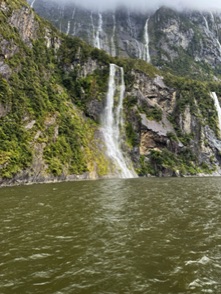
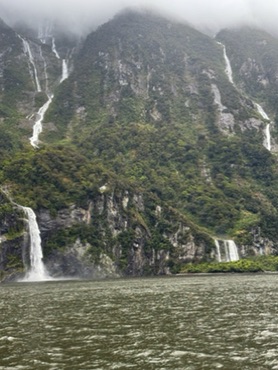
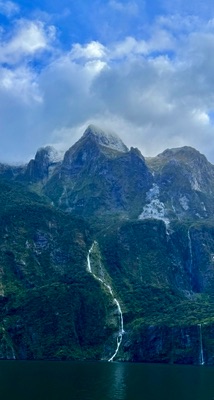
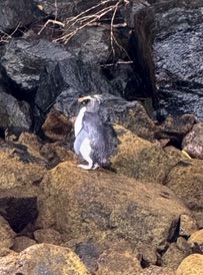
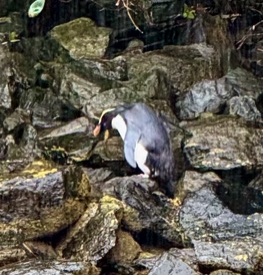
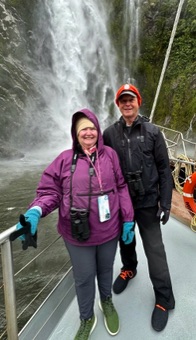
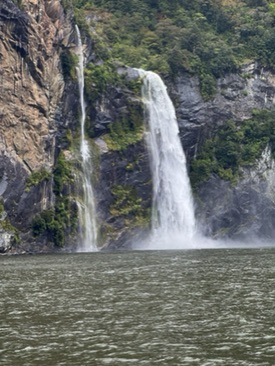
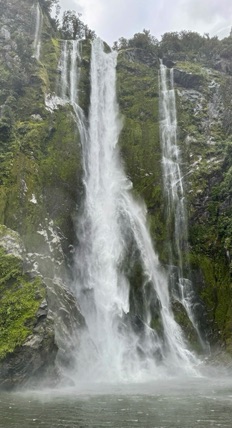
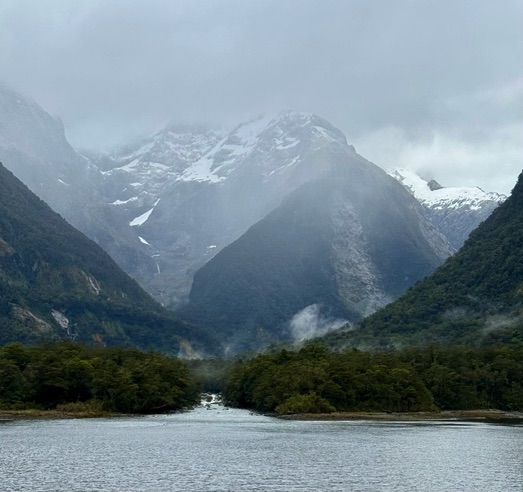
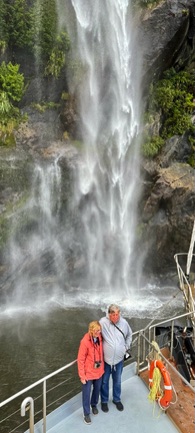
Tracy & I (and Earl & Lois) enjoying some cold spray. Because the cliffs are so severe, the boat cozies right up to the falls.
Left, I was told there are only two places in the world where you can see a fiord, rainforest and glacier from the same spot: Here and in Patagonia.
Left below, best shots I could get of a Fiordland crested penguin, one of two species in the Sound. Then it started to hail on us!
The next morning, we cruised out to the edge of the Tasman Sea, which was relatively and unusually calm. Amazing that the partial sun of the morning and no rain meant the waterfalls in the Sound had started to dissipate. But, man, was the wind strong!
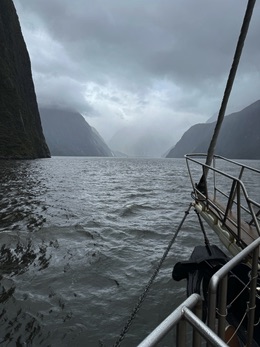
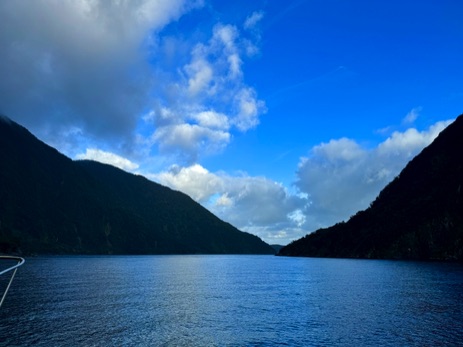

They have cruises that go out into the Sound on day trips; however, if you're going to spend all of that money just to get to New Zealand, we highly recommend you book an overnight cruise. You have a choice of spending an hour out on kayaks or in a zodiac (we chose the latter because of the rain). They feed you well and provide excellent commentary out on the water. Plus, the day cruises do not get out to the mouth of the Sound. Just sayin'.
After we disembarked from the ship, Kristin took us on another side adventure to a local raging river (I did say we got lots of rain, no?), where most of us enjoyed a nice hike. I'm on the left, going out as far as I dare; Jackie is being a bit more cautious; you had to shout to be heard. Below, Leslie, Kristin & Paula on the suspension bridge.
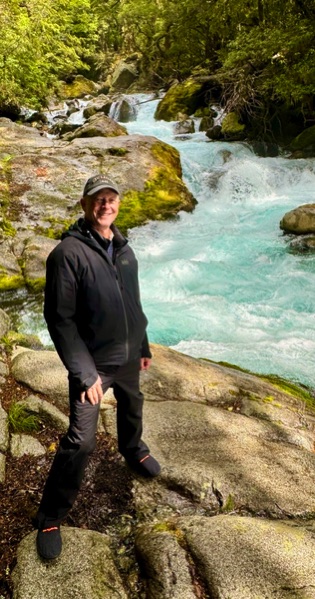
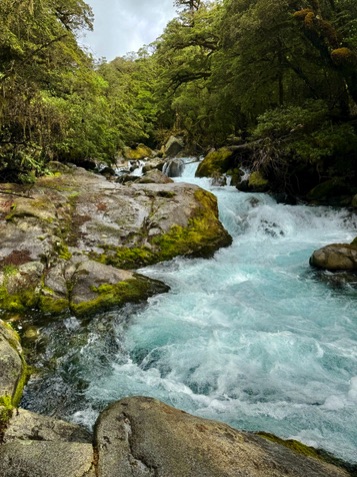
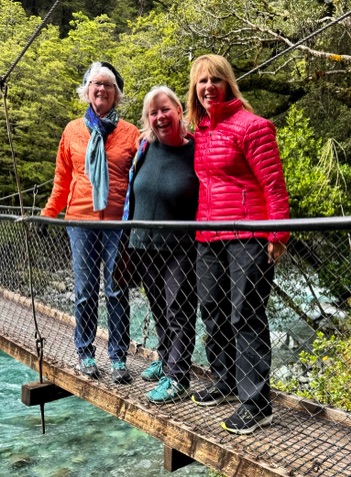
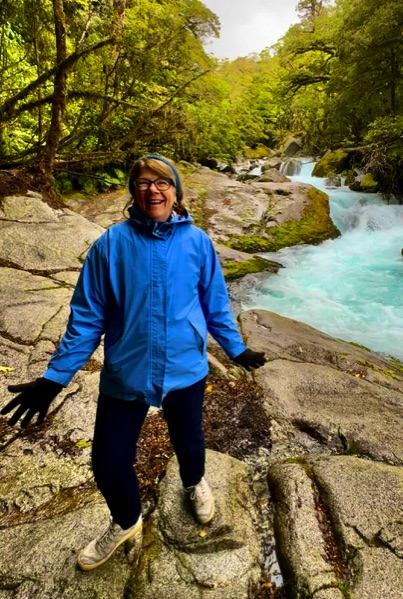
Queenstown! This is the terminus of our O.A.T. excursion; we spent several days in this delightful town. If I were to return to New Zealand - temporarily or permanently - this is the place I would come (population: 29,000). The Remarkables Mountains make a lovely backdrop over Lake Wakatipu, a 112-square-mile finger lake (Lake Tahoe is 191 sq mi), about 1,000 feet above sea level. It is in the heart of The Lord of the Rings filming. A tram takes you another 1,500 feet above the town, where there are plenty of mountain activities, winter and summer.
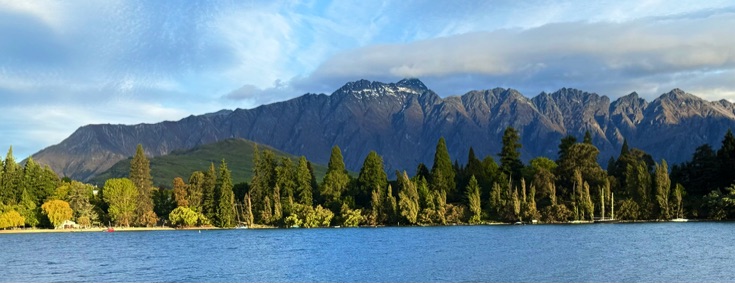
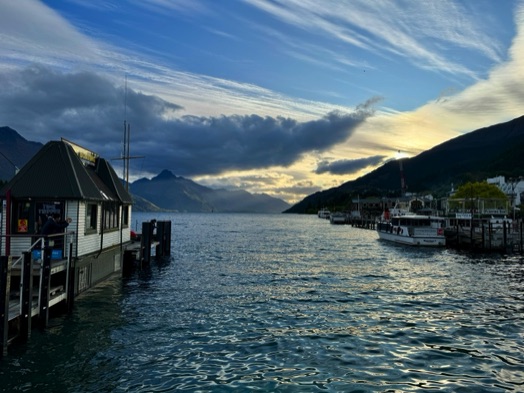

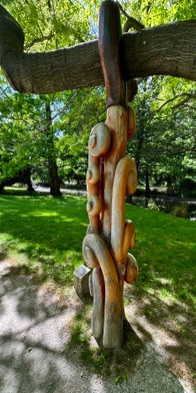
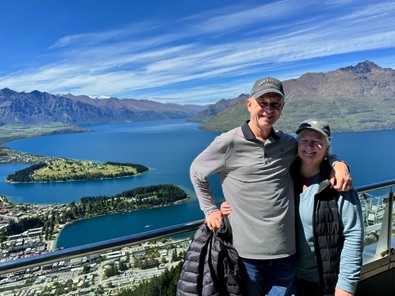
Milford Ssound was the highlight of our 18 days, but the two hours we spent jet-boating up and down the Dart River (aptly named) was the most thrilling. Most of us did this optional trip, and all had a blast. The Dart is a braided river, surrounded by gravel bars and 9,000 foot peaks, and flows placidly through the heart of Tolkien's Middle Earth. Besides the jet boats, there are hiking and trekking opportunities galore. We'll be back.
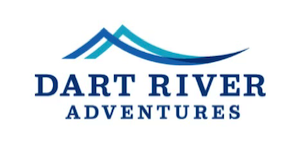
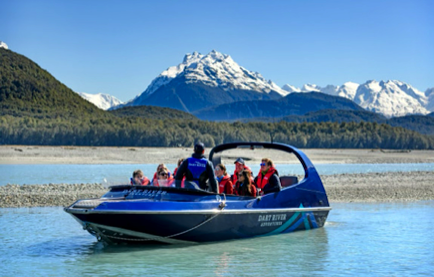
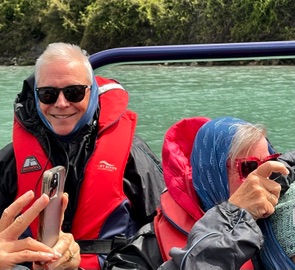
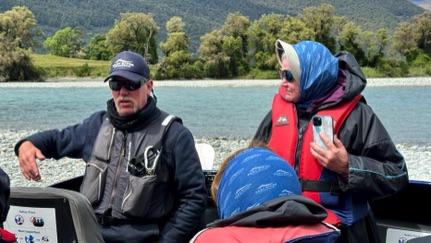
I'm in the back of the boat, so I was able to record some great videos; at high speed it felt like my iPhone was going to be ripped out of my hands, but it's amazing how steady the footage is; unfortunately, I'm not able to add it to this travel blog. That's Tracy up front with our pilot; she felt she was on an E-Ticket ride.
Right, Judi clearly is not having any fun; below, exotic Paula strikes a pose.
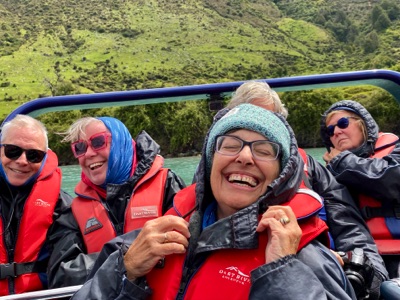
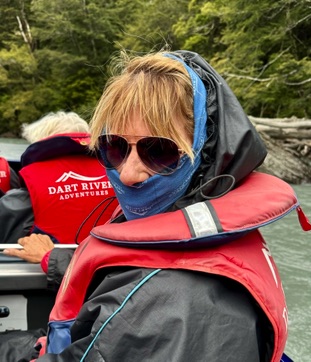
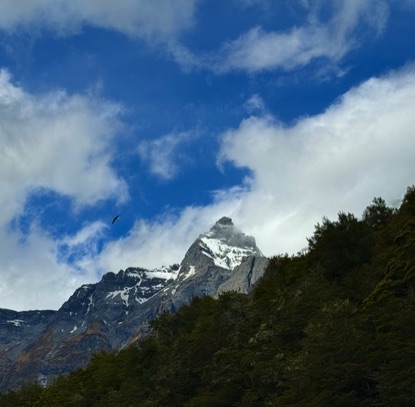
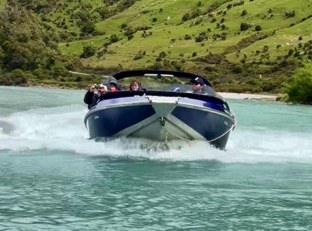
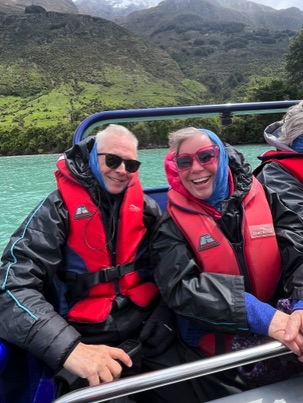
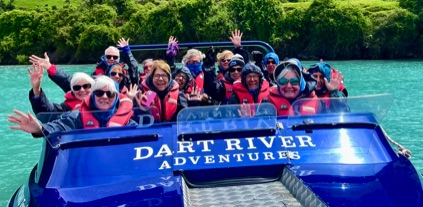

Our farewell dinner featured a ride across Lake Wakatipu aboard a 110-year-old vintage steamboat, the TSS Earnslaw. At the far end of the lake we gorged at the most comprehensive buffet I've ever seen; wine flowed freely. Afterwards, we watched another sheep-shearing demonstration and a remarkable performance by a talented sheep dog that raced 3oo yards up a steep slope to reign in his flock of sheep. Incredibly well-trained!
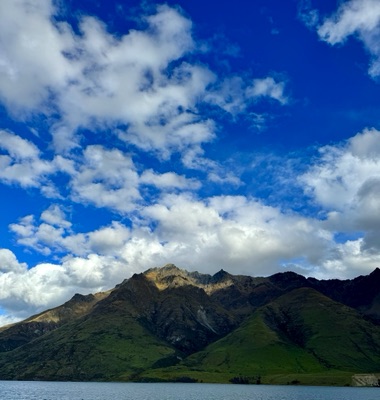
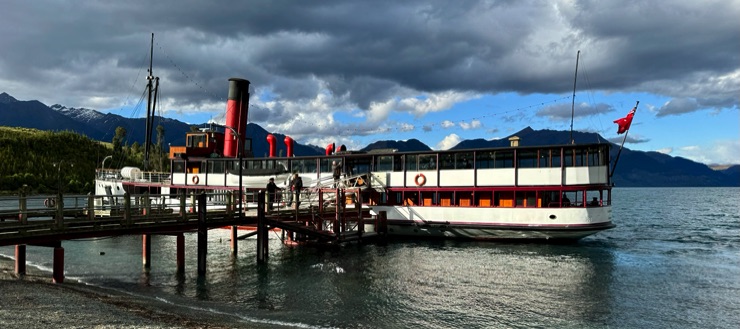
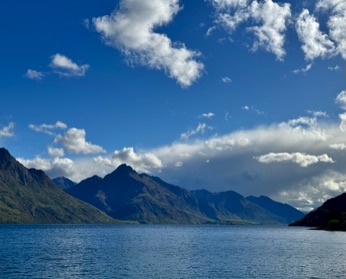
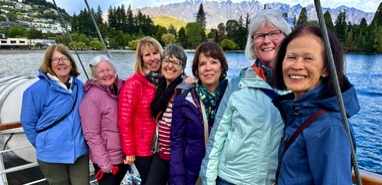
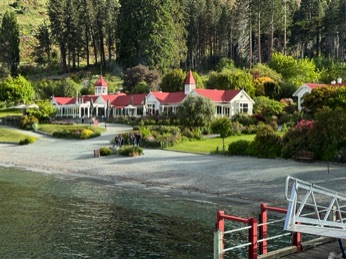
Our dinner destination above; right, Jackie, Tracy, Paula, Judi, Janet, Leslie & Velma enjoy our last night in Queenstown. Our sailing vessel below; it holds almost 400 people.